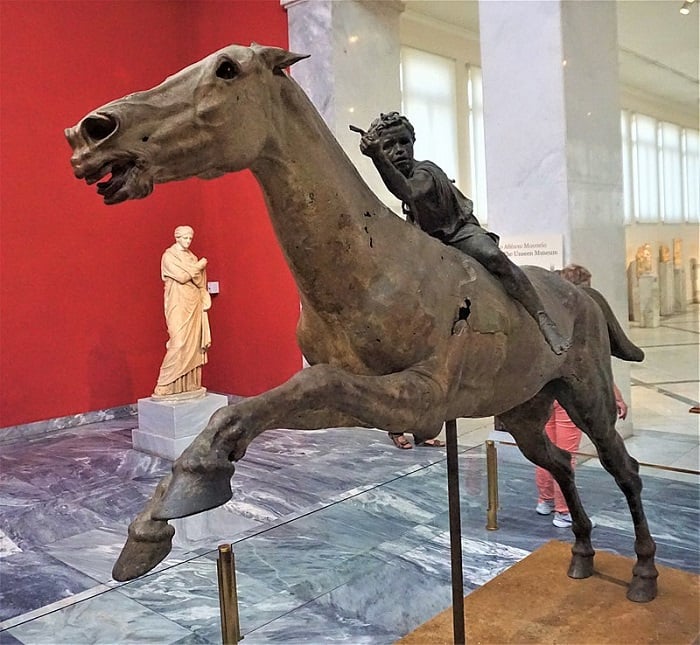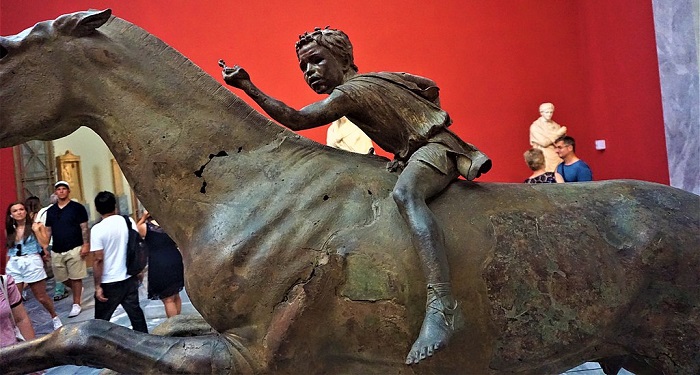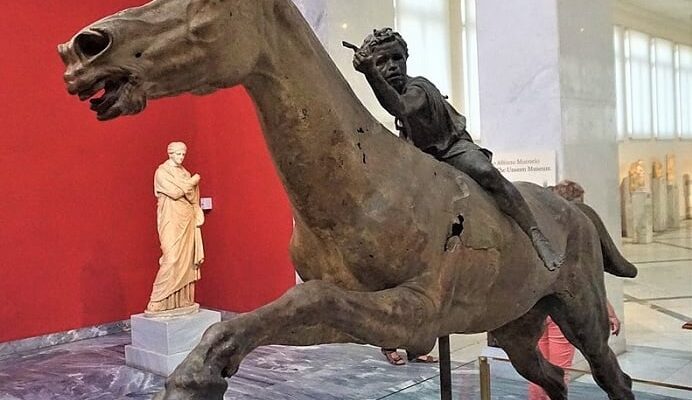
The Jockey of Artemision, a large Greek bronze sculpture of a young boy riding a horse, is a magnificent surviving statue from Ancient Greece and a rare example of a racehorse in Greek sculpture.
It was discovered in the fall of 1928 near Cape Artemision in north Euboea. The fragmentary bronze statues of a horse, a boy, and a god were retrieved from a sunken ship, and after much study and restoration, the horse and boy were paired together as a single sculptural group.
The statue is unique in its beauty. Adeline Coe, an archaeologist from Furman University recently gave perhaps the best description of what it symbolized.
The pair is captured in a moment of high drama, Coe writes in a Furman University publication.
“The horse has two legs lifted far off the ground, giving the impression that he gallops at full speed,” she writes. “His wide eyes, flattened ears, and exaggerated veins vividly show his strain. His wide nostrils, parted mouth, and lolling tongue almost enable the viewer to see him panting and frothing as he pushes through to the end of the race.”

“The boy sits astride his horse, his body leaning close to the animal’s neck to counterbalance the horse’s bounding gait,” she adds. “In one hand he grips a fragment of the preexisting reins while the other hand is poised to hold a whip or crop.
The drapery of his simple clothing and the locks of his hair flutter freely in the wind. His mouth hangs slack and open, showing his exhaustion to match that of the horse. Here, the bronze acts as a very expressive medium.”
Expression of Greece’s classical ideals
“The metallic sheen of his skin and the hide of the horse give off the appearance of glistening sweat,” the American scholar adds. “This horse and his boy showcase a paradigm often seen in Hellenistic sculpture—the combination of Greek Classical ideals with added expression, drama, and energy.”
The statue is dated to around 150 to 140 BC and is approximately life-sized, with a length of 2.9 meters (9.5 feet) and 2.1 meters (6.9 feet) high.
On display in the National Archaeological Museum of Athens, the Jockey of Artemision is a rare survivor. Most ancient bronzes were melted down for their raw materials some time after creation, but this one was saved from destruction when it was lost in a shipwreck in antiquity before being discovered in the twentieth century.

Jockey of Artemision artist unknown
The original artist and circumstances under which the work was created are unknown. However, archeologist Seán Hemingway has suggested that it may have been plundered from Corinth in 146 BC by the Roman general Mummius in the Achaean War and given to Attalus but lost while in transit to Pergamon.
Some parts of the Jockey of Artemision are missing, such as the rider’s whip and reins, and the horse’s bridle. The bronze of the rear legs is thicker, indicating that they were the statue’s primary means of support.
The image of the goddess Nike is engraved on the horse’s right thigh, holding a wreath in his raised hands.
The horse is huge in comparison to its jockey, who is a boy only 84 centimeters (2.76 feet) tall and perhaps ten years old. The boy is possibly from Africa based on his physiognomy and original black patinated surface coloring. His hairstyle, however, is Greek, suggesting a mixed heritage.



